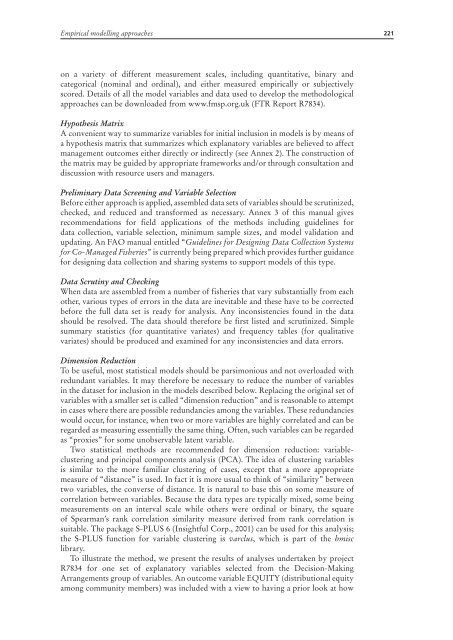Stock assessment for fishery management - Library
Stock assessment for fishery management - Library
Stock assessment for fishery management - Library
You also want an ePaper? Increase the reach of your titles
YUMPU automatically turns print PDFs into web optimized ePapers that Google loves.
Empirical modelling approaches 221on a variety of different measurement scales, including quantitative, binary andcategorical (nominal and ordinal), and either measured empirically or subjectivelyscored. Details of all the model variables and data used to develop the methodologicalapproaches can be downloaded from www.fmsp.org.uk (FTR Report R7834).Hypothesis MatrixA convenient way to summarize variables <strong>for</strong> initial inclusion in models is by means ofa hypothesis matrix that summarizes which explanatory variables are believed to affect<strong>management</strong> outcomes either directly or indirectly (see Annex 2). The construction ofthe matrix may be guided by appropriate frameworks and/or through consultation anddiscussion with resource users and managers.Preliminary Data Screening and Variable SelectionBe<strong>for</strong>e either approach is applied, assembled data sets of variables should be scrutinized,checked, and reduced and trans<strong>for</strong>med as necessary. Annex 3 of this manual givesrecommendations <strong>for</strong> field applications of the methods including guidelines <strong>for</strong>data collection, variable selection, minimum sample sizes, and model validation andupdating. An FAO manual entitled “Guidelines <strong>for</strong> Designing Data Collection Systems<strong>for</strong> Co-Managed Fisheries” is currently being prepared which provides further guidance<strong>for</strong> designing data collection and sharing systems to support models of this type.Data Scrutiny and CheckingWhen data are assembled from a number of fisheries that vary substantially from eachother, various types of errors in the data are inevitable and these have to be correctedbe<strong>for</strong>e the full data set is ready <strong>for</strong> analysis. Any inconsistencies found in the datashould be resolved. The data should there<strong>for</strong>e be first listed and scrutinized. Simplesummary statistics (<strong>for</strong> quantitative variates) and frequency tables (<strong>for</strong> qualitativevariates) should be produced and examined <strong>for</strong> any inconsistencies and data errors.Dimension ReductionTo be useful, most statistical models should be parsimonious and not overloaded withredundant variables. It may there<strong>for</strong>e be necessary to reduce the number of variablesin the dataset <strong>for</strong> inclusion in the models described below. Replacing the original set ofvariables with a smaller set is called “dimension reduction” and is reasonable to attemptin cases where there are possible redundancies among the variables. These redundancieswould occur, <strong>for</strong> instance, when two or more variables are highly correlated and can beregarded as measuring essentially the same thing. Often, such variables can be regardedas “proxies” <strong>for</strong> some unobservable latent variable.Two statistical methods are recommended <strong>for</strong> dimension reduction: variableclusteringand principal components analysis (PCA). The idea of clustering variablesis similar to the more familiar clustering of cases, except that a more appropriatemeasure of “distance” is used. In fact it is more usual to think of “similarity” betweentwo variables, the converse of distance. It is natural to base this on some measure ofcorrelation between variables. Because the data types are typically mixed, some beingmeasurements on an interval scale while others were ordinal or binary, the squareof Spearman’s rank correlation similarity measure derived from rank correlation issuitable. The package S-PLUS 6 (Insightful Corp., 2001) can be used <strong>for</strong> this analysis;the S-PLUS function <strong>for</strong> variable clustering is varclus, which is part of the hmisclibrary.To illustrate the method, we present the results of analyses undertaken by projectR7834 <strong>for</strong> one set of explanatory variables selected from the Decision-MakingArrangements group of variables. An outcome variable EQUITY (distributional equityamong community members) was included with a view to having a prior look at how
















